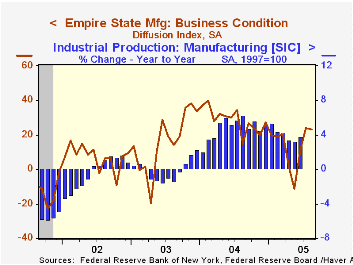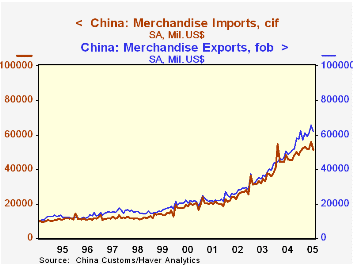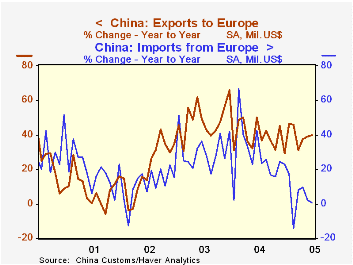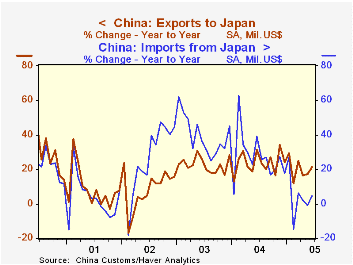 Global| Aug 15 2005
Global| Aug 15 2005Empire State Index Improved, Budget Deficit Estimate Reduced
by:Tom Moeller
|in:Economy in Brief
Summary
The Empire State Index of General Business Conditions in New York's manufacturing industries in August remained roughly at the same level as in July. At 23.04 versus 23.92, the two figures were the best back-to-back levels of the [...]

The Empire State Index of General Business Conditions in New York's manufacturing industries in August remained roughly at the same level as in July. At 23.04 versus 23.92, the two figures were the best back-to-back levels of the year.
The new orders component added to its earlier improvement and jumped to 33.75, the highest of the year, and the shipments index also rose. The employment index retraced all of the weakness of the prior four months while the prices paid index gained back virtually all of the July decline.
Like the Philadelphia Fed Index of General Business Conditions, the Empire State Business Conditions Index reflects answers to an independent survey question; it is not a weighted combination of the components.
The index of expectations for business conditions in six months rose sharply for the second consecutive month to the highest level since October of last year. Expectations for future capital spending remained about stable at the improved July level.
The Empire State Manufacturing Survey is a monthly survey of manufacturers in New York State conducted by the Federal Reserve Bank of New York. Participants from across the state in a variety of industries respond to a questionnaire and report the change in a variety of indicators from the previous month. Respondents also state the likely direction of these same indicators six months ahead. April 2002 is the first report, although survey data date back to July 2001.
For more on the Empire State Manufacturing Survey, including methodologies and the latest report, click here.
The Congressional Budget Office today updated its outlook for US budget deficits and the economy. The Federal budget deficit estimate for Fiscal Year 2005 was reduced to $331B from $365B projected in March but the FY2006 and FY2007 estimates were raised to $314B and $324B, respectively, from $298B and $268B.
Legislative (mostly Medicare) changes were estimated to cause the ten year deficit outlook, 2006-2015, to worsen by $1.2 trillion versus the earlier outlook.
The Budget Deficit and Economic Outlook: An Update from the Congressional Budget Office is available here.
Understanding the Twin Deficits: New Approaches, New Results from the Federal Reserve Bank of San Francisco can be found here.
| Empire State Manufacturing Survey | August | July | August '04 | 2004 | 2003 | 2002 |
|---|---|---|---|---|---|---|
| General Business Conditions (diffusion index) | 23.04 | 23.91 | 14.67 | 28.76 | 16.17 | 7.19 |
by Louise Curley August 15, 2005

China's exports of merchandise declined in July by $3,802 million from June, but since imports declined by $4,435 million, the trade surplus increased $633 million to $10,445 million from $9,812 million in June. The growth of the China's trade surplus over the past few years is evident in the first chart. Most of the surplus is with the United States. Countries other than the United States have, as a whole, run a trade deficit with China as can be seen in the table below.
Only total trade figures are available for July. The latest data on trade by country are for June. In the table below, we show China's total exports, exports to the United States and all other countries, total imports and imports from the United States and all other countries, and the total balance of trade and the balances for the United States and all other countries. While the surplus with the United States is still increasing in the first half of this year, there appears to be a sharp deceleration in the deficit with countries other than the U. S. In 2004 the deficit with these countries was $47,452 million, but in the first half of this year the deficit was only $3,645 million. There has been a decline in exports to these countries but a much greater decline in imports from them has reduced their deficit with China. The second and third charts show exports to and imports from Europe and Japan. The trends in the first half of this year shown in these charts are typical of most of the countries for which data are available. 

| China's Merchandise Trade (Million US$) | 2005 1st H | 2004 | 2003 | 2002 | 2001 | 2000 |
|---|---|---|---|---|---|---|
| Exports | ||||||
| Total | 365,996 | 593,633 | 438,398 | 325,596 | 266,108 | 249,202 |
| US | 78,152 | 124,973 | 92,512 | 69,959 | 54,319 | 52,142 |
| Rest of the world | 287,844 | 468,660 | 345,886 | 255,637 | 211,789 | 197,060 |
| Imports | ||||||
| Total | 315,594 | 560,765 | 412,840 | 295,170 | 243,554 | 225,092 |
| US | 24,105 | 44,653 | 33,883 | 27,228 | 26,204 | 22,365 |
| Rest of the world | 291,489 | 516,112 | 278,957 | 267,942 | 217,350 | 202,727 |
| Balance | ||||||
| Total | 50,402 | 32,868 | 25,558 | 30,426 | 22,554 | 24,110 |
| US | 54,047 | 80,320 | 58,629 | 42,731 | 28,115 | 29,777 |
| Rest of the world | -3.645 | -47,452 | -33,071 | -12,305 | -5,561 | -5,667 |
Tom Moeller
AuthorMore in Author Profile »Prior to joining Haver Analytics in 2000, Mr. Moeller worked as the Economist at Chancellor Capital Management from 1985 to 1999. There, he developed comprehensive economic forecasts and interpreted economic data for equity and fixed income portfolio managers. Also at Chancellor, Mr. Moeller worked as an equity analyst and was responsible for researching and rating companies in the economically sensitive automobile and housing industries for investment in Chancellor’s equity portfolio. Prior to joining Chancellor, Mr. Moeller was an Economist at Citibank from 1979 to 1984. He also analyzed pricing behavior in the metals industry for the Council on Wage and Price Stability in Washington, D.C. In 1999, Mr. Moeller received the award for most accurate forecast from the Forecasters' Club of New York. From 1990 to 1992 he was President of the New York Association for Business Economists. Mr. Moeller earned an M.B.A. in Finance from Fordham University, where he graduated in 1987. He holds a Bachelor of Arts in Economics from George Washington University.






